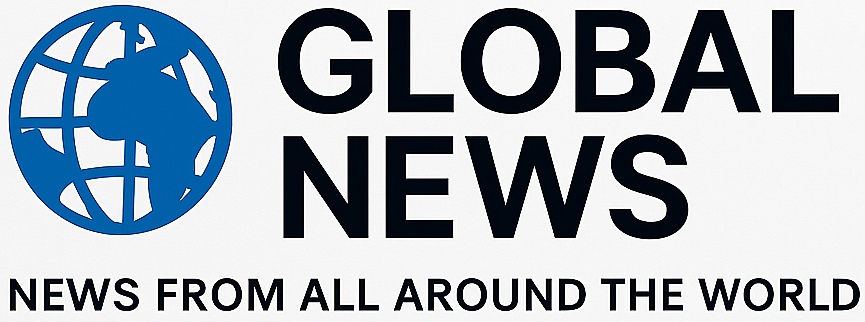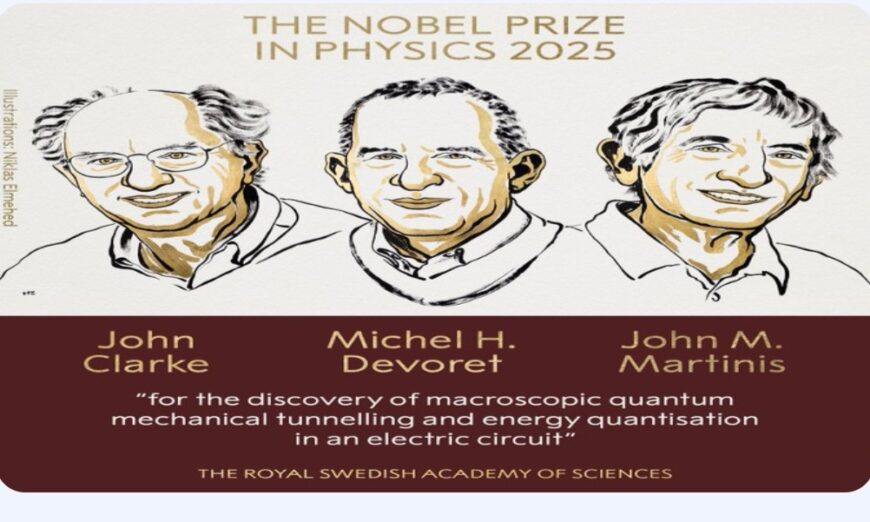Three scientists from the United States have won the 2025 Nobel Prize in Physics for groundbreaking experiments that showcased quantum physics in action using a chip.
Their work has paved the way for advancements in quantum computers, quantum sensors and quantum cryptography.
The laureates John Clarke, Michel Devoret and John Martinis are affiliated with the University of California and Yale University. Their experiments demonstrated quantum mechanical tunnelling and energy quantisation in an electrical circuit large enough to be held by hand.
This discovery confirms that quantum effects can exist on a macroscopic scale.
The Royal Swedish Academy of Sciences awarded the trio a prize of 11 million Swedish kronor. Experts hailed the achievement as a major step in the ongoing development of quantum technologies that could transform digital systems worldwide.
This continues a tradition of physics breakthroughs shaping modern technology and deepening scientific understanding.
One of the mind-boggling behaviours that particles are capable of here is “tunnelling”, literally, the ability of particles to pass through physical walls. It is as if a cricket ball hitting the pitch will surely bounce up, but the odd cricket-ball particle will simply burrow into the ground.
Such strange behaviour cannot be observed at the macroscopic level but these scientists showed that it was possible to organise a multitude of single particles and coerce them to exhibit “tunnelling” properties.
Much like early insight into quantum mechanics paved the way for transistors and silicon chips in the 1950s, the trio devised an electrical circuit with two superconductors, components that can conduct a current without any electrical resistance. They separated these with a thin layer of material – called a Josephson junction — that did not conduct any current at all.
In this experiment, they showed that they could control and investigate a phenomenon in which all the charged particles in the superconductor behave in unison, as if they are a single ‘particle’ that fills the entire circuit. Following this, they were able to demonstrate that such a particle could be made to behave simulating the flow of electricity even without voltage, a prerequisite for the flow of current.
These were akin to the first ‘super-conducting circuits’ that could potentially realise practical, useful quantum computers and quantum sensors. Quantum computers, unlike contemporary computers, deal in ‘qubits’, rather than binary bits.
This allows them to perform calculations exponentially faster but also threaten all kinds of encryption systems that are premised on bit-based computers taking the equivalent of forever to hack through the mathematical locks guarding security systems.
Therefore developing quantum-based computing system is a major research focus, including in India, which has a major National Quantum Computing Mission, that aims to build workable quantum computers by 2031.
“Quantum tunnelling of individual quantum particles, for example electrons, was known before, but this work done in the mid-80s was a path-breaking demonstration of the power of quantum physics that eventually led to new technology,” said Arindam Ghosh, physicist at the Indian Institute of Science, Bengaluru, and researcher in the field of quantum technology “
This purely fundamental experimental research with Josephson junctions nearly 40 years ago is the pillar of today’s understanding and engineering of superconducting qubits that may very well make tomorrow’s quantum computers.”
John Clarke was a professor at the University of California, Berkeley, in the U.S., where he had moved after completing his doctoral degree at the University of Cambridge, U.K., in 1968. At UC Berkeley he built up his research group and specialised in exploring a range of phenomena using superconductors and the Josephson junction.
By the mid-1980s, Michel Devoret had joined Clarke’s research group, after receiving his doctorate in Paris. This group also included the doctoral student John Martinis. Together, they took on the challenge of demonstrating macroscopic quantum tunnelling.
Because quantum states are sensitive to the slightest disturbance, vast amounts of care and precision were necessary to screen the experimental set-up from all the interference that could affect it.
They succeeded in refining and measuring all the properties of their electrical circuit, allowing them to understand it in detail. The trio will equally share the prize of 11 million Swedish kroner, or about ₹1 crore.
“It is wonderful to be able to celebrate the way that century-old quantum mechanics continually offers new surprises. It is also enormously useful, as quantum mechanics is the foundation of all digital technology,” said Olle Eriksson, Chair of the Nobel Committee for Physics, in an accompanying press statement.
There is no advanced technology used today that does not rely on quantum mechanics, including mobile phones, cameras… and fibre optic cables,” said the Nobel committee.
The announcement was made by the Royal Swedish Academy of Sciences at a news conference in Stockholm, Sweden.
“To put it mildly, it was a surprise of my life,” said Professor John Clarke, who was born in Cambridge, UK and now works at the University of California in Berkeley.
Michel H. Devoret was born in Paris, France and is a professor at Yale University while John M. Martinis is a professor at University of California, Santa Barbara.
The three winners will share prize money of 11 million Swedish kronor (£872,000).
The Nobel committee recognised breakthrough work performed by the three men in a series of experiments in the 1980s on electrical circuits.
In the words of the committee, “the discovery of macroscopic quantum mechanical tunnelling and energy quantisation in an electric circuit”.
Even for a field often considered dense, this discovery sounds bewildering.
But its implications have been profound and far-reaching. The electronic devices that most of us use rely on it, and the findings are being used to build extremely powerful computers.
“This is something that leads to development of the quantum computer. Many people are working on quantum computing, our discovery is in many ways the basis of this,” said Prof Clarke on the phone to the news conference moments after he was told he had won.
He appeared mystified that his work completed forty years ago is worthy of science’s most prestigious prize.
“I’m completely stunned. At the time we did not realise in any way that this might be the basis for a Nobel prize,” he said.
Quantum mechanics relates to the behaviour of tiny things in a tiny world. It refers to what particles like the electron do in the sub-atomic world.
Professor Clarke and his team looked at how these particles appeared to break rules like travelling through energy barriers that conventional physics said was impossible – something called “tunnelling”.
Using quantum “tunnelling”, the electron manages to burrow through the energy barrier.
Their work demonstrated that tunnelling can be reproduced not only in the quantum world, but also in electrical circuits in the ‘real world’.
This knowledge has been harnessed by scientists in making modern quantum chips.
“This is wonderful news indeed, and very well deserved,” said Professor Lesley Cohen, Associate Provost in the Department of Physics at Imperial College London.
“Their work has laid the foundations for superconducting Qubits – one of the main hardware technologies for quantum technologies.”
2024 – Geoffrey Hinton and John Hopfield for their work on AI and machine learning.
2023 – Pierre Agostini, Ferenc Krausz and Anne L’Huillier for work on attoseconds – extremely short pulses of light that can be used to capture and study rapid processes inside atoms.
2022 – Alain Aspect, American John Clauser and Austrian Anton Zeilinger for research into quantum mechanics – the science that describes nature at the smallest scales.
2021 – Syukuro Manabe, Klaus Hasselmann and Giorgio Parisi were given the prize for advancing our understanding of complex systems, such as Earth’s climate.
2020 – Sir Roger Penrose, Reinhard Genzel and Andrea Ghez received the prize for their work on the nature of black holes.
2019 – James Peebles, Michel Mayor and Didier Queloz shared the prize for ground-breaking discoveries about the Universe;

